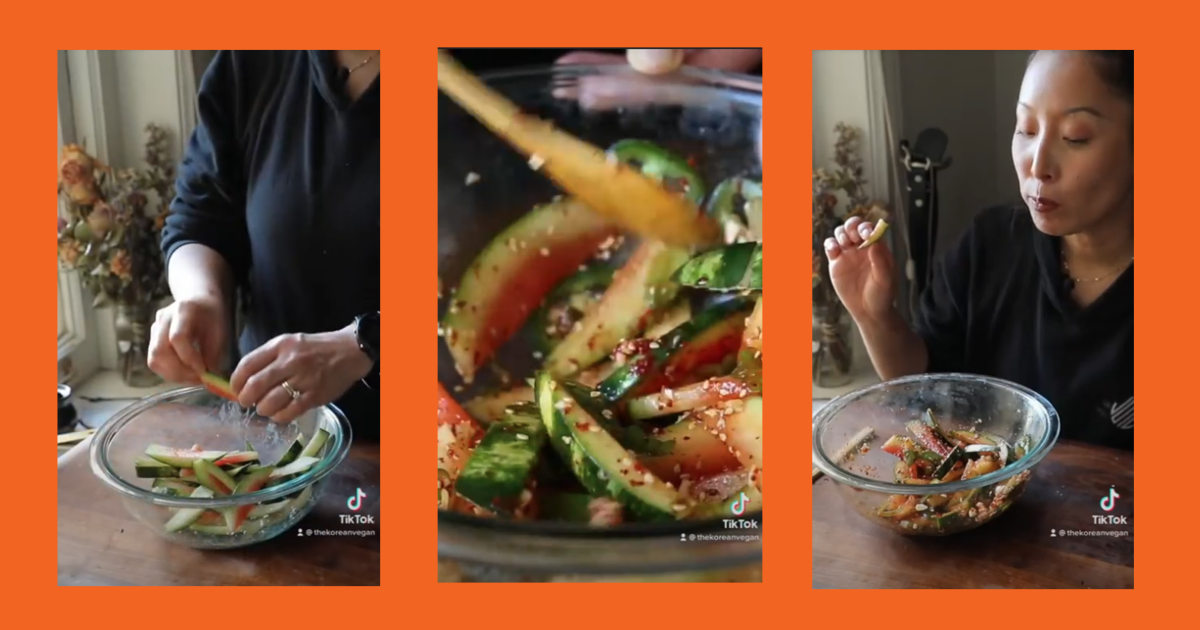
In a recent TikTok video, Joanne Molinaro, who goes by The Korean Vegan on the social media platform, mixes spices, presses tofu, wraps them in rice paper and fries them. As she prepares the ricepop tofu nuggets, she shares a vulnerable story about her mother’s fear of not fitting in.
It’s a typical video by Molinaro, who’s gained more than 3 million TikTok followers posting tutorials for a variety of vegan dishes and discussing issues like love, racism, familial trauma and heartbreak. And Molinaro isn’t alone. A wave of female Asian American creators are taking off on TikTok by talking about and offering tutorials on how to make Asian food. Many of them, like Molinaro, are then turning their popularity on the app into mainstream success, with book deals, sponsorships, music contracts and pop-up shops.
Before TikTok, Molinaro, 43, began content creation on Instagram, where she posted photos of her food. She said her plant-based diet, which she started in 2016, made learning how to cook a necessity.
“There just weren’t enough options. There were certainly no Korean options in Chicago,” she told NBC Asian America. “So, the only way I could eat was if I figured out how to prepare it myself.”
Once the pandemic hit, Molinaro said she needed an outlet for her feelings, and initially posted political content. “I was very angry with everything that was happening and I needed a place to channel that rage in an environment that I felt like is supportive,” she said.
She eventually pivoted toward her current style of storytelling.
Her videos include the sounds of her preparing food, like vegetables sizzling in the pan, with a voiceover telling personal stories about her life and family. “I wanted it to be moody. I wanted it to be a little bit darker and introspective because that’s the kind of art that I like,” she said.
Her videos usually garner hundreds of thousands of views and thousands of likes. Last year “The Korean Vegan Cookbook” was published.
“The goal of The Korean Vegan is to promote compassion, and through compassion, engage empowerment. I want people to feel things, like when they see something that’s wrong or hurtful, I want them to feel it. I don’t want them to become numb to it,” she said.
Her narrations include stories from decades ago, or her thoughts on current events. She also addresses topics like body dysmorphia, eating issues and the surge of anti-Asian hate. “I think that those moments are important too, to show people that I’m human. I struggle. I’m not perfect. You’re not alone.”
For Tway Nguyen, a Vietnamese American who goes by TwayDaBae on TikTok, creating food videos is about sharing her culinary heritage, which she said she’s always been proud of. “In school, I never felt the need to ever be like, ‘Hey Mom, can you pack me a peanut butter and jelly sandwich?’ Like, No, give me that braised pork belly, give me all of the Vietnamese food,” she said.
Like Molinaro, Nguyen, 27, initially created content on YouTube and Instagram. She shifted her focus to TikTok during the pandemic, when the app’s popularity took off. Since then, Nguyen has amassed over 590,000 followers. Her most popular video, a fried rice tutorial, went viral in March 2020.
Her TikTok fame has also translated to real life: She’s since hosted several pop-up shops selling dishes of recipes she’s used in her videos and is writing a cookbook.
Nguyen, a chef by trade, hopes to create accessible recipes for users. “I want people to feel like they’re competent in the kitchen because that’s how you invite people in,” she said. “That’s how to really help people get more confident.”
Chaheti Bansal, also known as RootedInSpice, also grew her following during the pandemic, amassing nearly 800,000 followers. Her videos, which consist of tutorials for everyday Indian and Indo-fusion cuisines, provide an intimate setting for users to learn recipes and understand the important relationship between food and Indian culture.
“My mom is a dal queen. Growing up, our pantry was always stocked with a dozen types of lentils,” she said in one video of the lentil soup that’s a common dish in many Indian households. Bansal, 27, continues the video with a simple dal recipe to “normalize making a 10-minute dal with the same ease we make 10-minute pasta from a box.”
Bansal said she knows she would be more successful if she created videos about Indian dishes that are popular in the U.S., like buttered chicken and shahi paneer, but said there are enough recipes for them. “I’d rather use my platform to talk about the recipes that we actually ate growing up,” she said.
Bansal’s most popular tutorial, tarbooz ki sabji, a savory watermelon vegetable dish made from the rinds, amassed over 39 million views on TikTok and spurred conversations about zero-waste consumption. Users also started documenting their own experiences making the dish.
Bansal said she didn’t expect the video to gain so much traction. “It’s a very, very like regional Rajanistani dish. So I was very surprised but I think that’s what’s cool about it. I think the curiosity for people is there, right?”
Bansal said she can still be true to her culture while creating videos that educate and excite viewers.
“Being authentic to how you grew up eating your food and how you grew up cooking is really important. Don’t be afraid that people won’t like it or they’ll find it gross. You’ll find your audience and you know, your people who do connect with you,” she said.
Source: | This article originally belongs to Nbcnews.com










